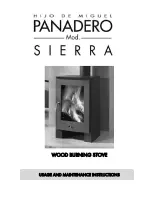
18
2.
Disassemble the transformer cover to
access the transformer and the connector
block. The wiring for the faulty component
can be disconnected and the faulty compo-
nent replaced.
3.
Reassemble the transformer cover and re-
fit the cover to the carrier bracket. Refit the
mate ‘n’ lock connection.
CONTROL VALVE RATING
The control valve is set by the manufacturer to give
the required fuel input for the Oisin oil stove.
To ensure that a satisfactory flame pattern will be
obtained, the oil flow rate must be checked before
initial lighting of the stove. As the oil flow rate is
very low, great care should be taken with this
procedure to ensure the accuracy of the flow rate.
Apparatus Required:
Collection vessel
Stopwatch
Graduated cylinder (capable of
measuring 50ml and graduated to
the nearest ml)
Very small flat screwdriver.
1.
Disconnect the oil feed line at the 90
o
compression fitting at the front of the burner
carrier tray. (See Fig.44)
2.
Place a collection vessel beneath the oil
line to catch the oil. Turn the control knob to
6. When the first drop of oil falls into the ves-
sel, start the stopwatch. Time the oil flow for
a minimum of 5 minutes.
3.
Measure the oil gathered in 5 minutes.
The rate should be approx. 8.5cc / min.
4.
Turn the control knob to 1. Using the same
procedure as outlined in 2 & 3 above, mea-
sure the minimum feed rate. The rate should
be approx. 4.2cc / min.
5.
If either of the above input rates are not
correct, the control valve can be adjusted to
give the required rate. The high fire screw is
to the right of the knob when looking at the
valve from behind, while the low fire knob is
to the left of the knob (see Fig.45). They
should only require slight adjustment and the
measurement procedure described in 2, 3 &
4 above should be followed to check each
adjustment.
6.
When the required input rate is achieved,
reassemble the compression fitting ensuring
that there are no leaks and that the burner is
level.
Fig.44
Fig.45
NOTE: It is imperative that the stove is not
rated above 9 cc/min as to do so will raise the
operating temperature of the stove which could
damage the control equipment or the stove
itself.
VITREOUS ENAMEL CLEANING
General cleaning must be carried out when the
stove is cool.
If the stove is finished in a high gloss vitreous enam-
el, to keep the enamel in the best condition observe
the following tips:
1.
Wipe over daily with a soapy damp cloth,
followed by a polish with a clean dry duster.
2.
For stubborn deposits a soap impregnated
pad can be carefully used on the vitreous
enamel.
3.
Use only products recommended by the
Vitreous Enamel Association, these products
carry the vitramel label.
4.
DO NOT USE ABRASIVE PADS OR OVEN
CLEANSERS CONTAINING CITRIC ACID
ON ENAMELLED SURFACES. ENSURE
THAT THE CLEANSER MANUFACTUR-
ERS INSTRUCTIONS ARE ADHERED TO.
ASSOCIATION
Содержание Oisin Oil MK II
Страница 18: ...19 WIRING DIAGRAM Fig 47...



































